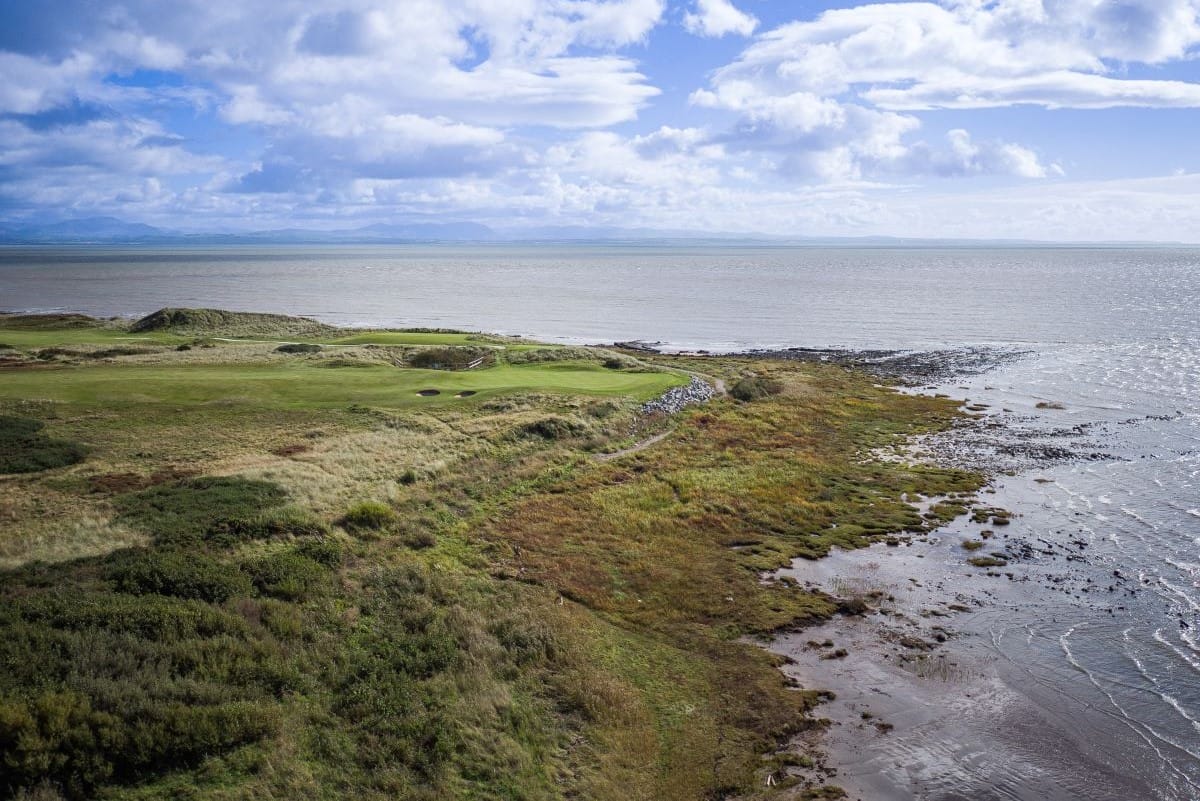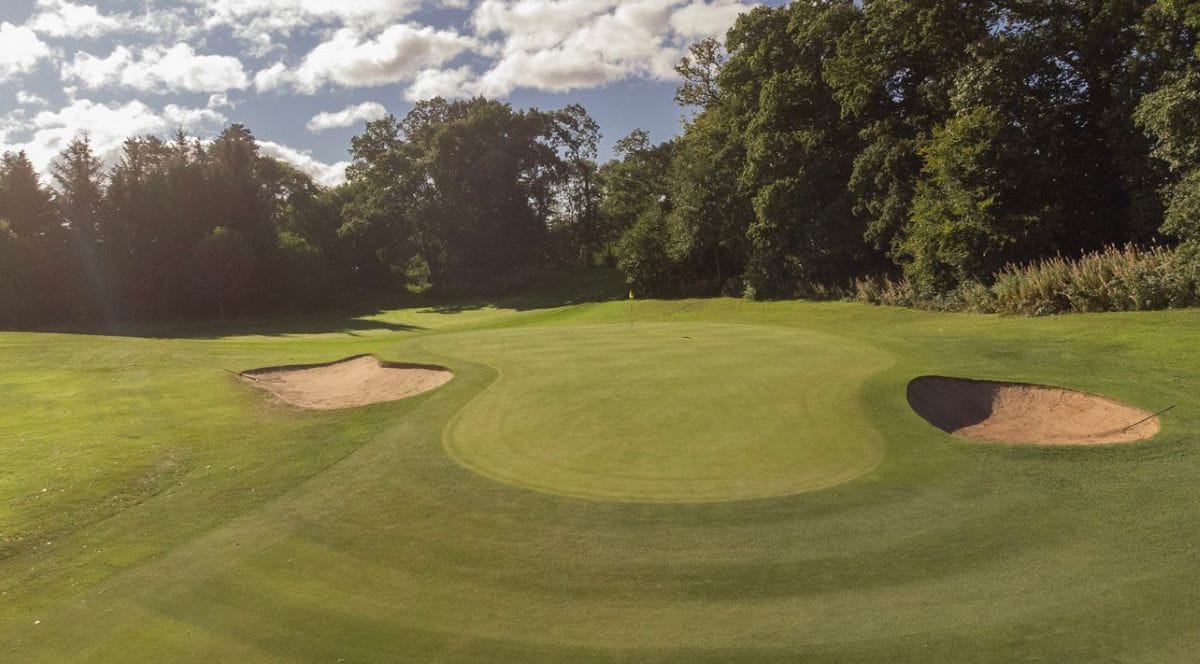A common Celtic ancestry, a common love for the uisce beatha, common rugged beauty, and a common distrust of our old colonial masters make Ireland and Scotland more than just sister nations – at just 12 miles apart, we’re practically connected.
But when it comes to golf, unquestionably, the Scots got there ahead of us. Playing golf in Scotland is something that should be on every golfer’s bucket list and recently, I ventured across the North Channel to see what the Dumfries and Galloway region have to offer.
Getting to Scotland is simplicity personified. Instead of being cramped inside a metal can at 36,000 feet, paying seven euro for a cup of tea and a Twix, the 150-minute StenaLine crossing allows for greater relaxation, with a side variety of food and beverage offerings, all at prices you’d expect to pay in most restaurants and cafes.
There are the added benefits of being able to venture outside for fresh air, a cigarette if that’s your thing, or to engage in a bit of whale watching, and also – as somebody whose clubs recently when AWOL in air transit can appreciate – the security of knowing that your golf bags are safely deposited in the boot of the car parked below deck.
Dumfries, known colloquially as Queen of the South, is around a ninety-minute drive from Cairnryan, and is an old market town whose older buildings are all constructed with the red sandstone of the nearby Locharbiggs Quarry, giving it a distinctive look and feel.
The Cairndale Hotel is close to the centre and is one of the aforementioned sandstone buildings. First opened in 1983, the Cairndale, in association with the region’s golf clubs, offer excellent package deals for players visiting the region, which include half-board accommodation and green fees for a variety of differing durations of stay.
The hotel restaurant serves a wide-range of culinary options, with the slow-cooked lamb shank particularly memorable due to the ‘melt in your mouth’ tenderness of the braised meat. A buffet-style breakfast affords guests the opportunity to help themselves to as little or as much of the full Irish – or in this case, full Scottish – ingredients, cereals, fruit, cold-cuts and pastries as they please.
You can even get some of what Sandy Lyle served up at the 1989 Masters Champions Dinner, and the haggis went down a lot better with me than it did with some of the Green Jacket-clad diners at Augusta National and when in Scotland, it’d be a sin not to try some.

The hotel also has a top-class Leisure Club with a large swimming pool, jacuzzi spa, sauna and a fully stocked gym, ideal for relaxing in post-round or for those who never feel quite right unless they’ve got the iron pumping.
But with a natural aversion to unnecessary strenuous activity, I opted to pass on the weights room and headed south to Scotland’s most southerly golf course.
Southerness Golf Club lies on the remote Southerness Point on the Solway Firth and the course was designed by Philip Mackenzie Ross shortly after the Second World War. Despite being relatively flat, the course is one of the most testing in the entire nation and its USGA slope rating of 148 attests that. To put that in context, Carnoustie, generally considered to be the most difficult course on the Open rota, has a slope rating of 145.
Southerness has hosted the Scottish Amateur Championship on four occasions, along with the Scottish Ladies, British Ladies, British Youths and numerous other top-class championships.
Interestingly, the golf course came within inches of disappearing off the map altogether. In the 1960s, in order to avoid the course being turned into a caravan park, wealthy businessman David Keswick purchased the land on which the course is built and leased it back to the club for a relative pittance. It wasn’t until the new clubhouse and car park were constructed in 1974 that club membership really began taking off, with lady members increasing by almost 50 percent in the first year, and country members increasing by 25 percent.
Extensive drainage work was carried out over a 30-year period and the architectural firm Clayton, DeVries and Pont, spearheaded by former Tour pro Mike Clayton, are set to further upgrade the course with a view to restoring it to its original intent with bunker replacement likely to be the most significant changes with the hope being that the work would be carried out over a five-year period.

The opening three holes are all par-4s, with out-of-bounds down the right-hand-side, though you have to be fairly wild to find it on one and two. The fairways appear quite spacious, but heather and gorse either side keep you on your toes and the third in particular, which doglegs from right to left, sees the OOB and gorse encroach closer to the closely mown grass.
With an average depth of 30 yards, the greens aren’t overly big by links golf standards, and there is a delicate blend of subtle and heavy contouring to make each green unique, and the putting surfaces on the par-3s in particular – with the exception of the 17th that is bunker-free – are surrounded by devilish bunkers meaning that accuracy on approach is a necessity if you’re to avoid running up big numbers.
A solid test of golf throughout, there are no weak holes, but the back-nine was where the course really comes alive. Starting with a par-3 with six greenside bunkers to contend with, the green slopes gently from right to left, and the prevailing wind sweeps in off the right side. Short enough to make you think you’ve a realistic birdie chance, and with a precise shot you do, but a tucked-right pin makes par a very good score.
The 12th is the standout hole from both scenic and architectural points of view. Playing back into the wind, it’s a long, sweeping dogleg from left to right, with three expertly placed fairway bunkers to contend with, before a second shot to a green protected by a pond short left, and two mounds either side, with the ocean perilously waiting to gobble up anything that goes long.
The green itself was in danger of falling victim to coastal erosion, but a community effort saw the construction of a retaining wall to help ward off the encroachment and preserve a hole selected by former Ryder Cup player and Sky Sports analyst Andrew Coltart as one of his favourite holes in the whole of Scotland.
Whilst the 12th may be the highlight, in a similar vein to the preceding 11, the closing six holes are again excellent and stiff challenges, culminating in the course’s second par-5 that gently sweeps left to right, whilst the wind encourages the ball to move in the other direction, meaning that it plays longer than the 500 yards it’s listed at off the back markers.

Superb value for money, Southerness’ remote location is the only thing keeping the green fees south of the £200 mark, and you can play it in high season for £80 midweek with twilight rates of around £55, while it’s an affordable £100 at the weekends.
After a well-earned cup of tea afterwards, we headed back to our base at the Cairndale Hotel, opting for an early dinner – again excellent – and headed off in search of the Hole I’ The Wa’ Inn which the welcoming Southerness members had informed us was a pub not to be missed.
One of the oldest in region, dating back to 1620, the Hole I’ The Wa’ was reputedly one of Robert Burns favourite watering holes, and the famed poet and lyricist who penned Auld Lang Syne among other works, and the bar’s 19th century landlord was an avid collector of Burns memorabilia that can now be seen in the nearby Robert Burns centre.
We had other things in mind, however, and as a real ale enthusiast I was more than happy to sample some of the local brews, before wisely opting to bid our farewells before the karaoke – a nightly tradition – kicked off.

The following morning, we headed to the nearby Dumfries and County Golf Club. A parkland layout situated just outside the town, 1883 Open Champion Willie Fernie was the original designer, but legendary architect James Braid was enlisted in 1926 and then again in 1934 to first improve and then lengthen the course after the club acquired additional land.
After turning over the land to the war effort in the 1940s, after hostilities ended, further land was purchased and MacKenzie Ross further reconstructed to form the layout we see today.
At 5,925 yards and par of 69, your first thoughts are short, but anybody familiar with the trio of architects will understand that that means little.
The course begins with a quirky Braid special, a short par-4 with a blind tee shot, first doglegging right, then with the large green – it doubles with the par-3 sixth – protected by tree cover, meaning that a fade round the corner, hugging the out of bounds adjacent right side will give the best angle for approach.
I particularly liked the third hole, a short, gentle right-to-left dogleg, with a blind tee shot for the bigger hitters and a blind approach for shorter hitters. The green – all of which are USGA standard, immaculately kept, and will be devilishly fast in mid-summer – is two tiered, making distance control imperative.
Steep run offs are very much a feature on the front nine, most notably on the first, fourth and fifth holes. The latter, named Spion Kop in tribute to famous Boer War battle, features an elevated tee shot down into the valley, before an uphill second shot to a green perched upon the hilltop, with only the horizon visible beyond, all the while with the river Nith running along the right-hand side.

Again, in mid-summer, anything short here will end up at the bottom of the hill, requiring a steep uphill pitch with only the top of the flag visible. Unfortunately, due to heavy rain – the wettest four months in living memory according to head pro James Erskine – the greens weren’t running their fastest and the penalties for coming up short not as severe as you’d expect on firmer ground, but it was enough to give a flavour of how tricky it could be.
Two relatively short par-4s start the back nine, but there’s a quick change of pace on 12 and 13, both of which play well over 400 yards and the mature trees that line the fairways, surround the greens and dictate lines of approach mean that par is a very good score and bridie putts extremely hard to come by.
Though there are no par-5s on the back nine, the two par-3s differ wildly. The first of these, the 14th, is just a wedge, but plays semi-blind with only the flag visible and the heavily contoured green, though circular when viewed from above, becomes an effective kidney bean shape due to the undulations that make front left to back left putts virtually impossible to get close. Not for everybody, it’s quirky enough to be interesting and would be my choice for a society nearest the pin. The second, the 16th, plays uphill and will put a fairway wood in most hands, and I’ve been reliably informed that its current baffling index rating of 14 is being changed to reflect the difficulty of the hole.
A blind tee shot awaits on the last, the fairway perched above high above the tee box, and, with OOB waiting behind the green, is a fitting way to end the round as accuracy and distance control are once again imperative.
In addition to Dumfries and County and Southerness Golf Clubs, Dumfries and Galloway Golf Club is also nearby, and though it wasn’t part of the itinerary on this trip, reviews suggest it is more than capable of holding its own alongside Dumfries and County, with Southerness the clear jewel in the region’s crown.

The Cairndale Hotel, offer packages from £269 per-person including two nights dinner, bed and breakfast and two rounds of golf across the, and more information can be found by clicking here.
























Leave a comment